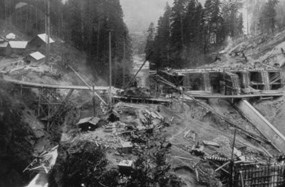
History of the Dam Construction: With the financial backing of Chicago investors and that of Canadian financier George Glines, he bought land along the river and began construction of the Elwha Dam in 1910. A Washington State law established in 1890 required fish passage devices on dams “wherever food fish are wont to ascend,” but Aldwell ignored the requirement. Fish Commissioner Leslie Darwin offered to waive that requirement if Aldwell built a fish hatchery adjoining the dam, so the dam could then be considered necessary for egg collection (Brown 1982). Although Aldwell initially balked at this proposal, a fish hatchery was built and began operation in 1915. It was abandoned by the State in 1922. Elwha Dam is a concrete, gravity structure. Because the dam was secured to the walls of the bedrock canyon, but not the bedrock underlying the river substrate, the foundation blew out in 1912 shortly after the reservoir (Lake Aldwell) filled. This new void under the dam was essentially plugged by adding fill material to the river below and upstream of the dam. Elwha Dam became operational in 1913. At a time when little electricity was available to the peninsula, the hydroelectric dam contributed to local economic prosperity. A demand for more power resulted in the installation of two additional turbines in a second powerhouse at Elwha Dam in 1922. Increasing power demands led to the construction of another dam just eight miles upstream of the Elwha Dam. The location of Glines Canyon with its narrow passage and high bedrock walls promised the yield of large amounts of energy. Glines Canyon Dam became operational in 1927. Before and After - The Elwha Dam
|
Last updated: May 2, 2025

